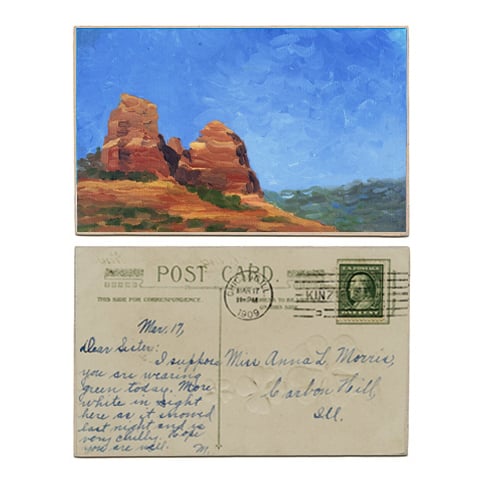
Google’s image search provides a great tool for artists, journalists and others, but there is a downside, as New York painter Cynthia Daignault discovered when she unintentionally illustrated a press release with a painting by Elisheva Biernoff.
For her project “The Mysterious Arrival of an Unusual Letter…,” Daignault is offering 180 unique, hand-painted postcards created during six months on the road leading up to a November-December 2015 show at Lisa Cooley, her New York gallery. She will paint a landscape from life for the front of the postcard and pen a related text for the back.
You can sign up online to get a postcard for $250. The humble postcard has a fine artistic heritage, having provided inspiration for artists ranging from Ray Johnson to Nina Katchadourian and On Kawara (see What On Kawara’s Analog Wisdom at the Guggenheim Has to Offer a Digital World).
In creating a press release for the show, Daignault searched online for images of the backs of vintage postcards by typing “back of postcard” into Google. She grabbed one to stand in as a stock image.
But the representation she found was not, as she assumed, the reverse of some antique postcard. Rather, it was a photorealistic painting on the same theme by Biernoff, who lives in San Francisco and is represented by that city’s Eli Ridgway Contemporary Art. Biernoff let Daignault know about the issue, and Daignault informed everyone on her mailing list that day.
Daignault has published a lengthy apology on her website, exploring the role of the seemingly endless and anonymous image bank provided by the Internet:
With such a great, vast and anonymous tool, there is perhaps a blasé attitude that everything on the internet is public domain and up for grabs. Such was the false assumption beneath my own error. There is an anonymity in the internet, but I now see that we must keep reminding ourselves, there is at least one real person behind every image. A real flesh and blood person with ideas, feelings, talent, and desires that we may be exploiting in any act of appropriation.
To be fair, when we typed “back of postcard” into Google just now, while it turned up over 63 million results, scrolling through the resulting images, after not too long we did come upon an image of one of Biernoff’s postcard works. The preview image was linked to the artist’s website.
Other artists have gotten in trouble for assuming that all images are in the public domain (see When Is Artist-on-Artist Theft Okay? Jamian Juliano-Villani and Scott Teplin Duke it Out). As Business Insider’s Shane Ferro wrote recently in an article about appropriation artist Richard Prince, “It might not be intuitive to someone who grew up with screenshot + paste that attribution is important.” Daignault’s apology serves as an example of the contrasting view.